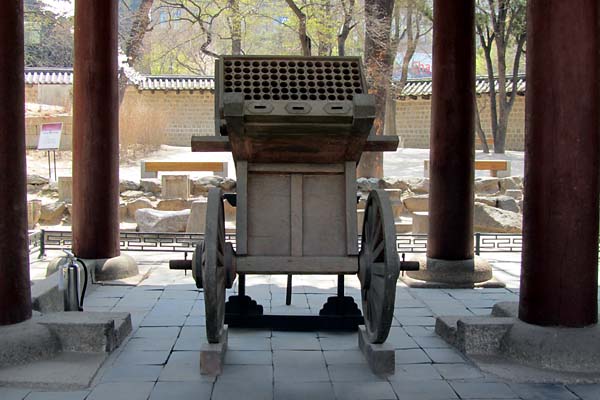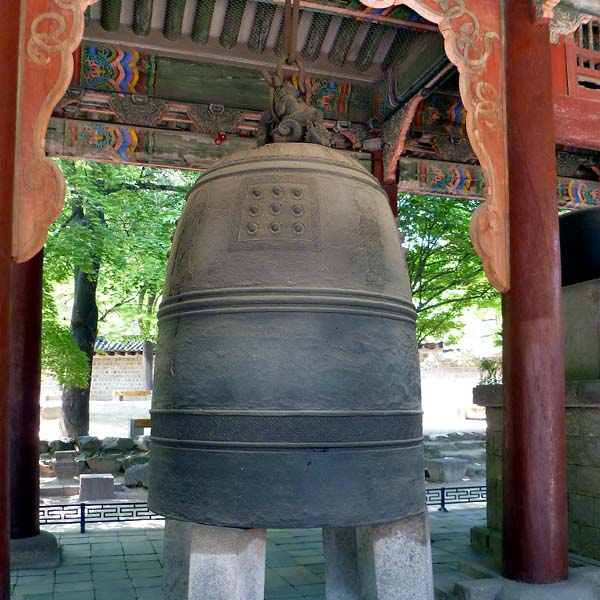
Gwangmyeong-mun
Deoksugung Palace
Seoul, Korea (Palace Map)
Gwangmyeong is currently a Gate to Nowhere. It was originally the entrance gate of Hamnyeongjeon, but in 1938 the Japanese moved it to its present location in front of Seokjojeon. Repurposed as an exhibition space, the gate currently displays a singijeon rocket launcher, an early Joseon bell from Heungcheonsa Temple, and the Borugak Jagyeongnu water clock.
According to its sign, "The singijeon is a weapon that was invented by Choe Museon at the end of the Goryeo Dynasty [1377]. It is an iron-tipped bamboo arrow with a paper-gunpowder rocket attached to the rear. When the rocket was lit, the weapon would launch. When fired, the carriage that carried the launcher was aimed at the proper angle, and then all the singijeon fuses were gathered together and lit at once. The firing range of the small singijeon was about 100 meters." The object displayed is a reproduction, but it should be accurate since blueprints still exist from the time such weapons were constructed.
"Heungscheonsa is a temple established by King Taejo, the founder of the Joseon dynasty, in 1397, to pray for Queen Sindeok's soul. The Heungcheonsa Bell was installed in 1462. Since Heungcheonsa was burned down in 1510, the bell was first moved to Gwanghwamun of Gyeongbokgung Palace in 1747, then to Changgyeonggung Palace, and finally to the present location." There is an inscription on the bell that mentions the royal donors, and there are some worn-down but still visible figures in relief on the shoulder of the bell. The hook of the bell is shaped like an elaborately coiled dragon. The bell is clapperless, like most East Asian bells. To ring, it would be struck on the side with a pole.

The Borugak Jagyeongnu (Water Clock of Borugak Pavilion) is classified as National Treasure No. 229. It is the original instrument, not a model, although all of its moving parts have been lost and only 3 water bowls and 2 cylindrical water containers remain. The cylindrical vessels are decorated with elaborate climbing dragons in raised relief. This is appropriate because the East Asian dragon is a water creature who lives in ponds and lakes, and also because this clock is a royal instrument. As such, it defined standard time throughout the country, much as atomic clocks do today.
The clepsydra was made in 1536. According to Wikipedia, "The water clock worked by having water poured into the largest bronze vessel which flowed into the smaller vessels which the flowed into the long water tanks. When the water level rose to the appropriate level, a floating rod touched a lever device which caused a ball to roll and hit another ball at the other end. The rolling ball would trigger the gong, bell, drum, and even a wooden puppet which marked the hour with a placard."
A working model of the instrument is located in the National Palace Museum of Korea, on the grounds of Gyeongbokgung Palace.


